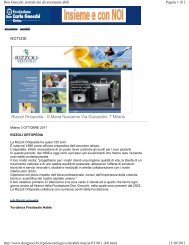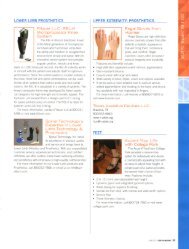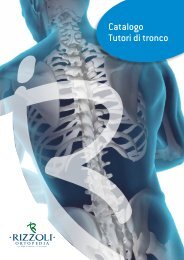Company Profile - Rizzoli Ortopedia
Company Profile - Rizzoli Ortopedia
Company Profile - Rizzoli Ortopedia
You also want an ePaper? Increase the reach of your titles
YUMPU automatically turns print PDFs into web optimized ePapers that Google loves.
LA NASCITA A FIANCO DELL’ISTITUTO RIZZOLI<br />
La storia della <strong>Rizzoli</strong> <strong>Ortopedia</strong> S.p.A., già Officine<br />
Ortopediche <strong>Rizzoli</strong>, inizia a Bologna nel 1896, quando<br />
fu inaugurato l’omonimo Istituto Ortopedico per volontà<br />
di Francesco <strong>Rizzoli</strong>, illustre medico ortopedico, ed<br />
emerse la necessità di dotare l’istituto di una Officina,<br />
per progettare e realizzare dispositivi ortopedici<br />
di supporto ed attrezzature clinico–ospedaliere<br />
necessarie all’attività medica. Per merito dei primi<br />
direttori dell’Istituto, il nome <strong>Rizzoli</strong> diventa in breve<br />
tempo uno dei più affermati a livello internazionale,<br />
come sinonimo di efficacia e qualità delle cure e di<br />
innovazione nella ricerca sperimentale. Seguendo le<br />
indicazioni terapeutiche del prof. Putti, le Officine<br />
realizzano varie tipologie di protesi e tutori<br />
personalizzati per i pazienti. È di quest’epoca la<br />
realizzazione del dispositivo Gonistat, che permetteva<br />
con un movimento delle spalle di bloccare<br />
l’articolazione del ginocchio fino a 90°.<br />
LA STORIA<br />
OUR HISTORY<br />
DA SEMPRE RIFERIMENTO<br />
TECNOLOGICO DI SETTORE<br />
Nel secondo dopoguerra vi fu un radicale cambiamento<br />
dei materiali utilizzati per l’assemblaggio delle protesi e<br />
nei metodi di lavorazione. È di questo periodo<br />
l'inserimento dei primi materiali plastici e delle relative<br />
tecniche di lavorazione che permisero di ottenere<br />
invasature leggere e precise. Negli anni ’60 le protesi<br />
scheletriche di arto inferiore e superiore migliorarono<br />
costantemente per qualità e affidabilità, grazie<br />
all'utilizzo di nuovi materiali plastici, leghe leggere di<br />
provenienza aereonautica e nuovi tipi di acciai. La<br />
continua ricerca sui prodotti e sui materiali innovativi ha<br />
permesso negli anni ‘70 e ‘80 di progettare e applicare<br />
nuove soluzioni all'avanguardia nei componenti per<br />
protesi e tutori d'arto inferiore e superiore.<br />
BORN TO SUPPORT THE RIZZOLI INSTITUTE<br />
The story of <strong>Rizzoli</strong> <strong>Ortopedia</strong> S.p.A., formerly Officine<br />
Ortopediche <strong>Rizzoli</strong>, begins in Bologna back in 1896,<br />
when the Orthopaedic Institute of the same name was<br />
founded by the decision of Francesco <strong>Rizzoli</strong>, a<br />
renowned orthopaedic physician. The need arose to<br />
provide the institute with a workshop for designing and<br />
making orthopaedic devices and clinical and hospital<br />
equipment needed for medical activity. Thanks to the<br />
first directors of the Institute, the name <strong>Rizzoli</strong> quickly<br />
became one of the best known internationally¸ as a<br />
synonym for effectiveness and quality of health care<br />
services and of innovation in experimental research.<br />
Following the therapeutic advice of prof. Putti, the<br />
Workshops made various kinds of customised<br />
prostheses and orthoses for patients. It was then that<br />
the Gonistat device was made, allowing the patient to<br />
lock the articulation of the knee up to 90° through a<br />
movement of the shoulder.<br />
A CONSTANT TECHNOLOGY<br />
BENCHMARK FOR THE FIELD<br />
After the second world war, a radical change took place<br />
in the materials used for assembling prostheses, and in<br />
the methods used to make them. This was when the<br />
first plastic materials were introduced, together with<br />
their processing techniques, and this made it possible to<br />
obtain light and accurate sockets. During the ’60’s,<br />
lower and upper limb modular prostheses constantly<br />
improved in terms of quality and reliability, thanks to<br />
the use of new plastic materials, light alloys coming<br />
from the aeronautics industry and new kinds of steel.<br />
During the 70’s and 80’s, continuous research on<br />
innovative products and materials made it possible to<br />
design and apply new solutions which were the cutting<br />
edge in components for prostheses and orthoses for<br />
the upper and lower limb.














